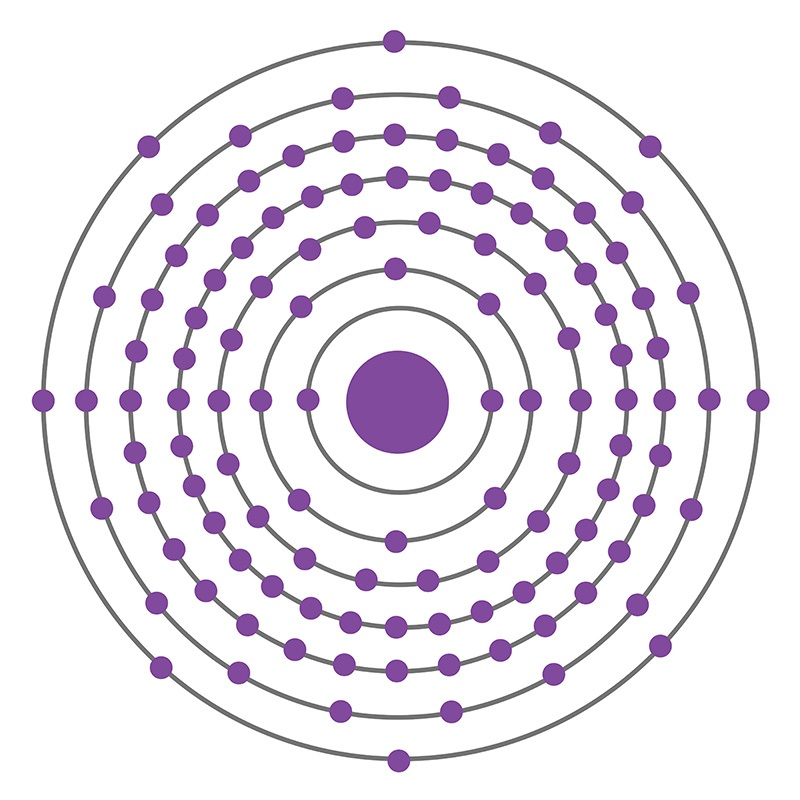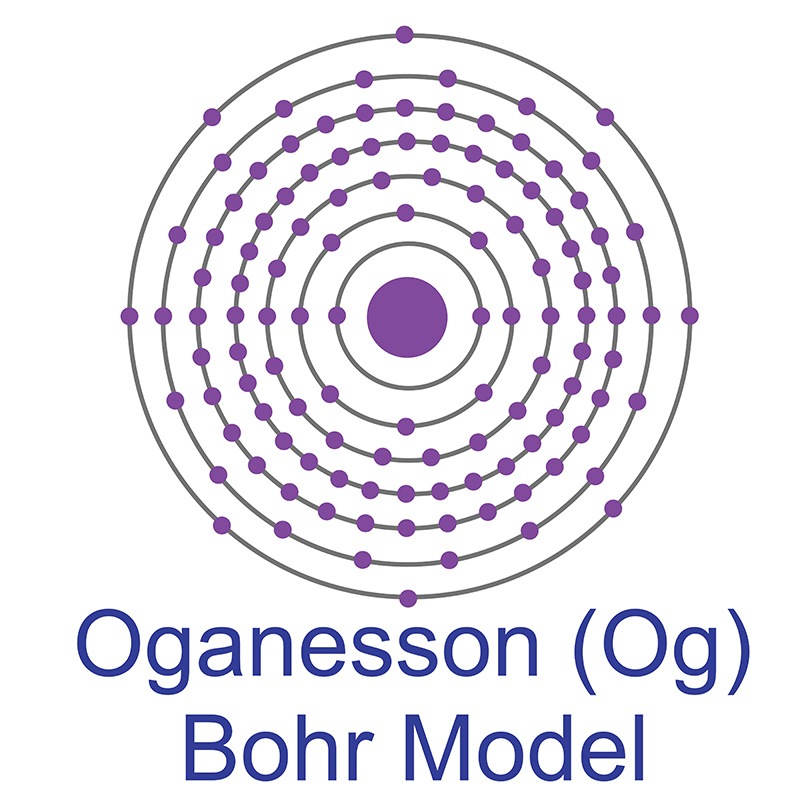About Oganesson

Oganesson (Og), formerly known as Ununoctium (Uuo), is the transactinide element with atomic number 118. In 2015, IUPAC officially credited a team composed of Russian and American researchers with the official discovery of the element. The collaboration included scientists from the Joint Institute of Nuclear Research in Dubna, Russia, and the Research Institute for Advanced Reactors, Dimitrovgrad, along with American teams from the Lawrence Livermore National Laboratory, Oak Ridge National Laboratory, Vanderbilt University in Tennessee, and the University of Nevada, Las Vegas. Their method of synthesis required a collision of californium and calcium ions to trigger a decay reaction resulting in the formation of 294UUo.
As the official discoverer of both elements 117 and 118, the collaboration was given the naming rights to both. In honor of the American half of the team, element 117 received the name Tennessine based on the location of Vanderbilt University. Element 118 was given the name Oganesson in honor of the lead Russian scientist Yuri Oganessian. Though very few of its properties can be observed, Oganesson is expected to exhibit characteristics of the noble gas group of elements based on its location on the periodic table.
Oganesson Properties
 Oganesson is a P-Block, Group 18, Period 7 element. The number of electrons in each of Oganesson's shells is 2, 8, 18, 32, 32, 18, 8 and its electronic configuration is [Rn] 5f14 6d10 7s27p6. In its elemental form ununoctium's CAS number is 54144-19-3. Oganesson was first detected in 2002 by research scientists at the Joint Institute for Nuclear Research in Dubna, Russia. Oganesson has the highest atomic number and highest atomic mass of all the elements detected thus far.
Oganesson is a P-Block, Group 18, Period 7 element. The number of electrons in each of Oganesson's shells is 2, 8, 18, 32, 32, 18, 8 and its electronic configuration is [Rn] 5f14 6d10 7s27p6. In its elemental form ununoctium's CAS number is 54144-19-3. Oganesson was first detected in 2002 by research scientists at the Joint Institute for Nuclear Research in Dubna, Russia. Oganesson has the highest atomic number and highest atomic mass of all the elements detected thus far.
Oganesson information, including technical data, properties, and other facts are specified below. Scientific facts such as the atomic structure, ionization energy, abundance on Earth, conductivity, and thermal properties are included.
| Symbol: |
Og |
| Atomic Number: |
118 |
| Atomic Weight: |
294 |
| Element Category: |
unknown |
| Group, Period, Block: |
18 (noble gases), 7, p |
| Color: |
unknown (presumably colourless) |
| Other Names: |
Ununoctio |
| Melting Point: |
N/A |
| Boiling Point: |
80±30 °C, 170±50 °F, 350±30 K (predicted) |
| Density: |
13.65 g·cm3 (predicted) |
| Liquid Density @ Melting Point: |
N/A |
| Density @ 20°C: |
N/A |
| Density of Solid: |
5700 (predicted, other prediction 5000) kg·m3 |
| Specific Heat: |
N/A |
| Superconductivity Temperature: |
N/A |
| Triple Point: |
N/A |
| Critical Point: |
N/A |
| Heat of Fusion (kJ·mol-1): |
23.5 kJ·mol-1 (predicted) |
| Heat of Vaporization (kJ·mol-1): |
19.4 kJ·mol-1 (predicted) |
| Heat of Atomization (kJ·mol-1): |
N/A |
| Thermal Conductivity: |
N/A |
| Thermal Expansion: |
N/A |
| Electrical Resistivity: |
N/A |
| Tensile Strength: |
N/A |
| Molar Heat Capacity: |
N/A |
| Young's Modulus: |
N/A |
| Shear Modulus: |
N/A |
| Bulk Modulus: |
N/A |
| Poisson Ratio: |
N/A |
| Mohs Hardness: |
N/A |
| Vickers Hardness: |
N/A |
| Brinell Hardness: |
N/A |
| Speed of Sound: |
N/A |
| Pauling Electronegativity: |
N/A |
| Sanderson Electronegativity: |
N/A |
| Allred Rochow Electronegativity: |
N/A |
| Mulliken-Jaffe Electronegativity: |
N/A |
| Allen Electronegativity: |
N/A |
| Pauling Electropositivity: |
N/A |
| Reflectivity (%): |
N/A |
| Refractive Index: |
N/A |
| Electrons: |
118 |
| Protons: |
118 |
| Neutrons: |
176 |
| Electron Configuration: |
[Rn] 5f14 6d10 7s27p6 |
| Atomic Radius: |
152 pm (predicted) |
Atomic Radius,
non-bonded (Å): |
Unknown |
| Covalent Radius: |
157 pm (predicted) |
| Covalent Radius (Å): |
1.57 |
| Van der Waals Radius: |
N/A |
| Oxidation States: |
-1, 0, +1, +2, +4, +6 (predicted) |
| Phase: |
Solid |
| Crystal Structure: |
N/A |
| Magnetic Ordering: |
N/A |
| Electron Affinity (kJ·mol-1) |
0.056 |
| 1st Ionization Energy: |
839.4 kJ·mol-1 |
| 2nd Ionization Energy: |
1450 kJ·mol-1 |
| 3rd Ionization Energy: |
N/A |
| CAS Number: |
54144-19-3 |
| EC Number: |
N/A |
| MDL Number: |
N/A |
| Beilstein Number: |
N/A |
| SMILES Identifier: |
N/A |
| InChI Identifier: |
N/A |
| InChI Key: |
N/A |
| PubChem CID: |
N/A |
| ChemSpider ID: |
N/A |
| Earth - Total: |
N/A |
| Mercury - Total: |
N/A |
| Venus - Total: |
N/A |
| Earth - Seawater (Oceans), ppb by weight: |
N/A |
| Earth - Seawater (Oceans), ppb by atoms: |
N/A |
| Earth - Crust (Crustal Rocks), ppb by weight: |
N/A |
| Earth - Crust (Crustal Rocks), ppb by atoms: |
N/A |
| Sun - Total, ppb by weight: |
N/A |
| Sun - Total, ppb by atoms: |
N/A |
| Stream, ppb by weight: |
N/A |
| Stream, ppb by atoms: |
N/A |
| Meterorite (Carbonaceous), ppb by weight: |
N/A |
| Meterorite (Carbonaceous), ppb by atoms: |
N/A |
| Typical Human Body, ppb by weight: |
N/A |
| Typical Human Body, ppb by atom: |
N/A |
| Universe, ppb by weight: |
N/A |
| Universe, ppb by atom: |
N/A |
| Discovered By: |
Joint Institute for Nuclear Research |
| Discovery Date: |
2002 |
| First Isolation: |
N/A |
Oganesson Isotopes
Oganesson is an artificial element. It has no stable isotopes.
| Nuclide |
Isotopic Mass |
Half-Life |
Mode of Decay |
Nuclear Spin |
Magnetic Moment |
Binding Energy (MeV) |
Natural Abundance
(% by atom) |
| 294Og | 294.21392(71)# | 890 µs | α to 290Lv | N/A | N/A | N/A | - |

 Oganesson is a P-Block, Group 18, Period 7 element. The number of electrons in each of Oganesson's shells is 2, 8, 18, 32, 32, 18, 8 and its electronic configuration is [Rn] 5f14 6d10 7s27p6. In its elemental form ununoctium's CAS number is 54144-19-3. Oganesson was first detected in 2002 by research scientists at the Joint Institute for Nuclear Research in Dubna, Russia. Oganesson has the highest atomic number and highest atomic mass of all the elements detected thus far.
Oganesson is a P-Block, Group 18, Period 7 element. The number of electrons in each of Oganesson's shells is 2, 8, 18, 32, 32, 18, 8 and its electronic configuration is [Rn] 5f14 6d10 7s27p6. In its elemental form ununoctium's CAS number is 54144-19-3. Oganesson was first detected in 2002 by research scientists at the Joint Institute for Nuclear Research in Dubna, Russia. Oganesson has the highest atomic number and highest atomic mass of all the elements detected thus far.